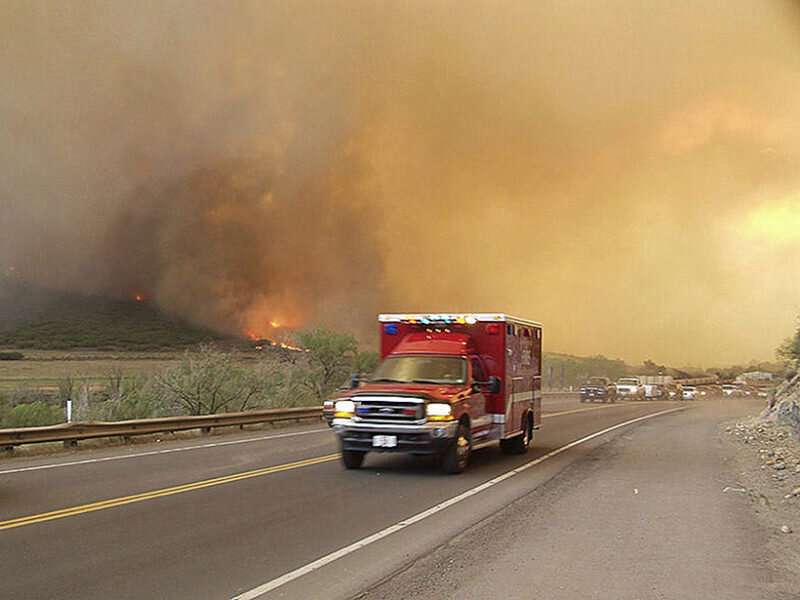A new study finds that a prolonged or severe smoke event has the potential to strain hospital resources. Here, an ambulance passes a long line of residents evacuating the Coal Seam Fire in Colorado in 2002. Credit: Loco Steve, CC BY 2.0
Wildfires are becoming worse and more frequent. Massive plumes of smoke—more dangerous than urban pollution—disperse across entire continents, spreading inhalable particles that can cause smoke-related fatalities and exacerbate a range of medical conditions far from the actual burn site.
In a new study, Sorensen et al. compared the concentration of inhalable smoke particles to local hospital intensive care unit (ICU) admissions by ZIP code. They found that an increase in smoke particles in an area was followed 5 days later by a small but measurable bump in ICU admissions.
The researchers then simulated a severe, weeklong smoke scenario. In such conditions, ICU admissions increased by a projected 131%—potentially enough to push an ICU past its capacity, especially in smaller hospitals with fewer resources.
Because ICUs care for critically ill patients with life-threatening conditions, they require resources. They must have on hand equipment necessary to monitor and support each patient's overwhelmed organ systems. For example, ICUs often have one-to-one nurse-to-patient ratios, and the urgency of care means hospitals must have rapid transportation to and between facilities. A surge in ICU admissions due to smoke particles may also take resources away from other hospital patients. When resources are spread too thin, hospitals cannot meet patient needs, and care may be compromised.
On the basis of hospital records, the authors found that young, asthmatic patients who respond quickly to smoke pollution get admitted to ICUs immediately after smoke exposure, while older patients with cardiovascular complaints tend to be admitted after a delay. Prolonged, severe events could endanger children most, because their lungs are affected quickly following smoke exposure, which means hospitals would have less time to secure extra resources. In addition, because there are fewer children's ICUs, children across a wide area are often transported to the same regional center.
Scientists predict that climate change will bring more frequent and more intense fires. Fortunately, current systems can predict inhalable smoke emissions with fine spatial resolution and up to 2 days in advance. With proper systems in place, hospitals can use that information to allocate resources more efficiently and warn areas far from the burn site and potentially unaware of the danger.
More information: Cecilia Sorensen et al, Associations Between Wildfire‐Related PM 2.5 and Intensive Care Unit Admissions in the United States, 2006–2015, GeoHealth (2021). DOI: 10.1029/2021GH000385
Provided by American Geophysical Union
This story is republished courtesy of Eos, hosted by the American Geophysical Union. Read the original story here.






















